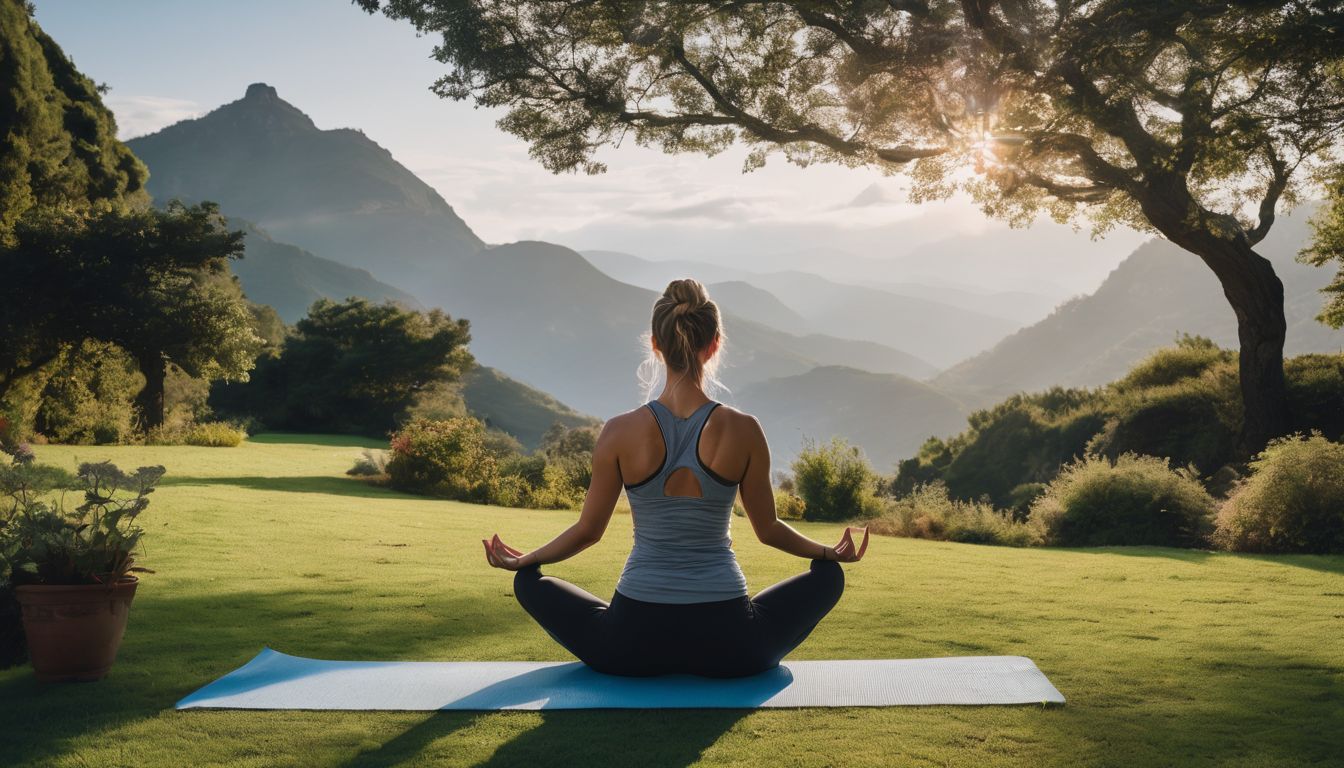
Lower back pain after working out can be a real bummer. Did you know that weak core muscles are often to blame? This article will show you how to ease your pain and keep it from coming back.
Stick around for some game-changing tips!
Key Takeaways
- Weak core muscles contribute to lower back pain, so strengthening them is essential. Exercises like planks and Russian twists can build a strong foundation.
- Keep hydrated because lack of water affects spine health. It’s important to drink fluids before, during, and after exercise to keep muscles functioning well.
- Correct posture while exercising, such as maintaining a neutral spine during squats, helps distribute weight evenly and prevents strain on the back.
- Recognize when pain is more than muscle soreness. Severe or ongoing discomfort may signal something serious like sciatica or disc issues that require medical attention.
- Use treatments like ice packs for inflammation and seek help from professionals for tailored recovery plans if you experience lower back pain post-workout.
Understanding Lower Back Pain After Working Out

Lower back pain after a workout can be caused by overuse injuries, weak core muscles, dehydration, or pre-existing conditions. It’s important to understand the possible reasons behind your lower back pain in order to address it effectively.
Overuse injuries
Overuse injuries often strike those who push their bodies without adequate rest, especially in workouts involving lifting weights or intense lower extremity exercises. These types of injuries result from repetitive stress on the muscles, tendons, and ligaments surrounding your spine and can lead to conditions like lumbar strain or herniated discs.
Consistently performing heavy deadlifts or back squats without proper form increases the risk for these painful setbacks.
Having a strong abdomen and glutes is pivotal for stabilizing your core during physical activity to prevent overtraining-related damage. Physical therapists emphasize balancing muscle groups to support the spine correctly and avoid undue pressure on any single area.
They may suggest targeted exercise routines that incorporate abdominal strengthening and flexibility training as part of injury prevention strategies. Transitioning smoothly into understanding weak core muscles helps maintain focus on spinal health in the realm of workout-related back pain.
Weak core muscles
Transitioning from the stress of overuse injuries, it’s crucial to consider how weak core muscles contribute to lower back pain. Core stability is foundational for preventing injury during physical activities.
Your abdominals, obliques, and transverse abdominal work in harmony with your back muscles to support your spine. Without a strong core, the body compensates by overworking other muscles, leading to an imbalance that can cause strain and discomfort in the lower back.
Strengthening your core doesn’t just ward off pain; it enhances overall balance and stability which are vital for any kind of movement. Keep in mind that exercises targeting these muscle groups should be done carefully to avoid exacerbating back issues.
Techniques such as the McKenzie method can effectively bolster your midsection while keeping your spine safe. Engaging regularly in workouts that focus on strengthening the quads, gluteal muscles, and other parts of the lower extremities also contributes significantly to a solid and supportive core structure.
Dehydration
While weak core muscles certainly play a role in lower back pain, dehydration can also be a sneaky culprit. Your body needs water for muscles and discs in your spine to stay healthy and function properly.
When you’re dehydrated, these tissues lose elasticity and their ability to cushion the vertebrae decreases — leading to increased risk of back injury during workouts.
Drinking plenty of fluids before, during, and after exercise is crucial. Not only does it help maintain muscle health, but proper hydration also ensures nutrients are delivered to your cells, waste products are removed efficiently, and your blood volume remains adequate to prevent strain on your heart.
Ignoring your body’s need for water can lead to stiffness and pain that hinders performance and recovery from physical activities like those intense barbell squats or sprints.
Pre-existing conditions
Pre-existing conditions such as arthritis or osteoporosis can make individuals more prone to experiencing lower back pain after a workout. These underlying health issues may contribute to weakened spinal structures, making the back more susceptible to strain and injury during physical activity.
It’s important for those with pre-existing conditions to work closely with healthcare professionals to develop exercise plans that minimize the risk of exacerbating their condition.
Individuals with pre-existing conditions must take extra care when engaging in physical activities, ensuring that they are mindful of their body’s limitations and seek appropriate guidance from medical experts before starting any new exercise routines.
When Lower Back Pain After Working Out is Normal vs. Cause for Concern

It’s normal to experience some muscle soreness after a workout, especially if you’ve pushed yourself harder than usual. However, if your lower back pain is severe and accompanied by numbness or tingling in your legs, it could be a sign of a more serious issue like sciatica or a herniated disc.
Additionally, if the pain persists for more than a few days despite rest and conservative treatment, it’s crucial to seek medical attention to rule out any underlying injuries or conditions.
Understanding the difference between regular post-workout discomfort and potential red flags can help you make informed decisions about when to push through the pain and when to take a step back for proper evaluation and treatment.
Treatment Options for Lower Back Pain Post-Workout
Experiencing lower back pain after a workout can be frustrating, but there are several effective treatment options available to help alleviate discomfort and promote recovery. Here are some ways to manage and address lower back pain post-workout:
- Apply ice pack or cold compress to the affected area for 15 – 20 minutes multiple times a day to reduce inflammation and numb the area.
- Use over-the-counter anti-inflammatory medications such as ibuprofen or aspirin to help relieve pain and swelling in the lower back.
- Perform gentle stretching exercises targeting the lower back and surrounding muscles to improve flexibility and reduce tension.
- Seek professional care from a physical therapist who can provide specific exercises, manual therapy, and other modalities tailored to your condition.
Preventing Lower Back Pain After a Workout
Maintaining a neutral spine during squats or bending, strengthening your core muscles, regular stretching, and incorporating pool exercises as a low-impact option to alleviate back pain are effective ways to prevent lower back pain after working out.
Maintaining a neutral spine during squats or bending
To avoid lower back pain during and after your workout, it’s crucial to maintain a neutral spine during squats or bending. This helps distribute the load evenly and minimizes strain on your lower back. Here are some key techniques to achieve this:
- Engage your core muscles to support your spine while performing squats or bending movements.
- Keep your chest up and shoulders back to prevent rounding of the upper back which can lead to lower back discomfort.
- Focus on hinging at the hips when bending instead of rounding your lower back, maintaining a slight arch in your lower back.
- Use a mirror or ask a trainer for feedback on your form to ensure proper alignment throughout the movement.
Strengthening your core muscles
To prevent lower back pain after a workout, strengthening your core muscles is crucial. This helps support your spine and improve overall stability. Here are effective ways to strengthen your core muscles:
- Plank exercises: Engage your entire core by holding a plank position for increasing durations.
- Russian twists: Sit on the floor, lean back slightly, and rotate your torso from side to side while holding a weight or medicine ball.
- Bicycle crunches: Lie on your back and bring opposite knee towards elbow in a pedaling motion, engaging the abdominal muscles.
- Stability ball exercises: Utilize a stability ball for exercises like crunches, pelvic tilts, and leg lifts to challenge and strengthen your core.
- Dead bug exercise: While lying on your back, lift opposite arm and leg in the air while maintaining a neutral spine to engage the core muscles.
- Boat pose: Sit on the floor, lean back slightly, lift your legs up at an angle, and balance on your sit bones to engage the entire core.
- Side planks: Support yourself on one forearm and foot while keeping the body in a straight line to engage the obliques and overall core stability.
Regular stretching
Regular stretching helps to improve flexibility and reduce muscle tension, preventing lower back pain after a workout. Incorporating dynamic stretches like leg swings, arm circles, and torso twists can enhance blood flow and warm up the muscles before exercise. Static stretches such as hamstring stretch, calf stretch, and quadriceps stretch help to lengthen the muscles and increase range of motion, reducing the risk of injury during physical activity. Additionally, including yoga or Pilates in your routine can aid in strengthening core muscles while improving flexibility. Engaging in a consistent stretching regimen post-workout can alleviate muscle tightness and promote recovery.
Pool Exercises as a Low-Impact Option to Alleviate Back Pain
Engage in pool exercises to alleviate back pain as the buoyancy of water reduces pressure on your spine. Swim laps, perform water aerobics, or do gentle stretches in the pool to strengthen your back muscles without straining them.
Incorporating pool exercises into your routine can help improve flexibility and range of motion while providing a low-impact option for managing and preventing lower back pain.
To alleviate back pain with low-impact exercises, consider aquatic therapy which utilizes the natural resistance of water to build strength and promote healing. The weightlessness of water reduces stress on joints and muscles, making it an effective choice for individuals experiencing discomfort during regular exercise.
Conclusion
Understanding and preventing lower back pain after working out is crucial for maintaining a healthy, active lifestyle. Educating yourself about the causes of lower back pain and taking proactive measures to strengthen your core muscles can help reduce the risk of injury.
Incorporating proper form, regular stretching, and low-impact exercises can also contribute to minimizing the occurrence of post-workout lower back pain. By implementing these preventive strategies, individuals can mitigate the likelihood of experiencing discomfort and continue enjoying their fitness routines without interruption.
FAQs
1. What causes lower back pain after working out?
Lower back pain after working out can be caused by delayed-onset muscle soreness (DOMS), hyperextending the muscles or even acute injuries like strains or dislocations.
2. How can I tell if my back pain is serious?
If your low back pain comes with fever, weakness in your legs, or severe discomfort that doesn’t improve, you might need a physical exam, MRI, CT scan or x-rays to figure it out.
3. Can wearing compression stockings help prevent lower back pain?
Wearing compression stockings isn’t directly linked to preventing low back pain; they are more for managing conditions in the veins of your feet and legs.
4. Should I see a doctor for lower back pain after exercising?
Yes, seeing a doctor is wise especially if you have ongoing or sharp acute pain so they can run diagnostic tests like an electromyogram to check on muscle health around your spine and buttocks.
5. What’s one way to ease lower back soreness from exercise?
One method of easing sore neck and low-back discomfort include taking anti-inflammatories and muscle relaxants as needed alongside restful recovery periods post-exercise.
6. Are there any exercises that could cause less strain on my lower back?
Strengthening core muscles through targeted physical therapy exercises can reduce the risk of hyperextending the back during workouts thus preventing some forms of low-back ache.



